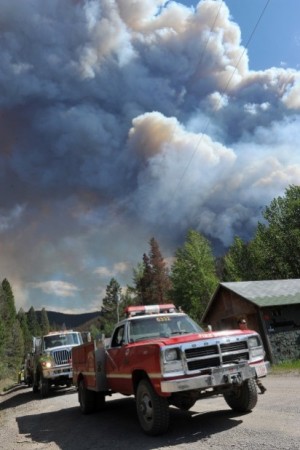
The Helena National Forest has released their report on the Davis prescribed fire that escaped on August 26, 2010 and burned over 2,000 acres of private and U.S. Forest Service land 11 miles southeast of Lincoln and 28 miles northwest of Helena in Montana.
The firefighters ignited a test burn at 10:45 a.m on Wednesday, August 26. By 2:00 p.m. strong winds became a problem and the fire moved into the tree canopy. All ignition ceased, but soon there was a spot fire which burned 20 acres in heavy mixed conifers. When all personnel left the fire at 10:00 p.m. to avoid the hazard of falling trees, the spot fire had been partially lined.
The next day, Thursday, additional personnel were on scene. They were completing the fireline and gridding for other spot fires when an undetected one took off at 1:00 p.m. which quickly transitioned to a crown fire. The prescribed fire was declared an escape at 1:15 p.m. and a Type 2 Incident Management Team was requested at 2:27 p.m. By nightfall the fire was estimated at over 1,600 acres on federal land and 450 acres on private lands involving multiple landowners. Approximately 22 structures were evacuated on Thursday afternoon and evening.
The five-person review team consisted of three US Forest Service employees, one from the Bureau of Land Management, and one from the state of Montana.
The Helena Independent Record today quotes Kevin Riordan, the Helena National Forest Supervisor, about the findings from the report.
“I don’t want to push anything off or say it was no big deal on any of those things, but each of the factors identified in and of themselves were not a huge piece where we can say, ‘Jeez, here’s something clearly that we did wrong, done incorrectly or that we’re going to make big changes on,'” Riordan said on Monday. “I think there are some small pieces of something that adds up to be a bigger thing. Those are what we are trying to dial into and focus in on so we can make some changes.”
I will go beyond Mr. Riordan’s assessment, and go out on a limb and say there are at least two “huge pieces” that were clearly “done wrong”.
1. The first issue was the failure to take notice of the spot weather forecast that was issued at 10:43 a.m. Wednesday on the day of the burn, just before the firefighters ignited the test burn. That forecast predicted stronger winds than in the forecast that was issued the previous day which was for “winds upslope 3 to 6 mph, ridge top winds southwest 5 to 10 mph with gusts to 15 mph”. Here is what Wednesday morning’s forecast predicted for the day of ignition (the all-caps are from the weather forecast, a bad habit the NWS needs to break):
WIND (20 FT)……..SOUTHWEST WINDS 10 TO 15 MPH WITH AFTERNOON GUSTS 20 TO 25 MPH.
RIDGE TOP WIND……WEST AT 15 TO 20 MPH.
The report says:
The prescribed fire personnel stated they did not note any differences between the two forecasts.
That forecast also stated that on the following day, Thursday, the winds in the afternoon would be 30 to 35 mph. The maximum wind speed allowed in the prescription for the project was 15 mph, which, from my experience, is quite high for a prescribed fire.
2. The second issue is the fact that they knew on Tuesday, the day before the burn began on Wednesday, that near record heat and a Fire Weather Watch with gusty southwest winds was forecast for Thursday. This Watch was upgraded to a Red Flag Warning on Wednesday afternoon after ignition had begun. Even in a best case scenario, if there had been no spot fires or other control problems on Wednesday, the 30 to 35 mph winds predicted for the day after ignition should have alerted experienced fire management personnel that the winds across the 100-acre prescribed fire could have caused embers to be blown across the lines, resulting in the fire escaping. Control would have been difficult in 30 to 35 mph winds.
We wrote about the escaped fire as it was burning in August. This Wildfire Today search page lists some of the Wildfire Today articles about the fire.
